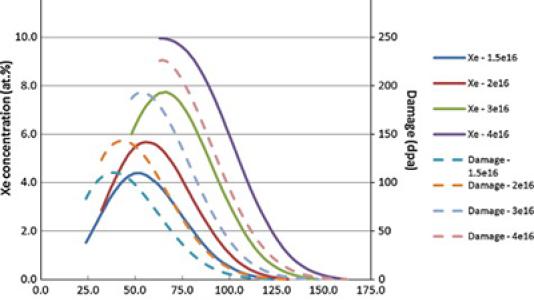
In order to study irradiation damage and inert gas bubble formation and growth behaviors, and to provide results and insights useful towards the validation of a multi-scale simulation approach based on a newly developed Xe-Mo inter-atomic potential, in situ Transmission Electron Microscopy (TEM) studies of Xe implantations in pure single crystal Molybdenum (Mo) have been conducted. 300keV and 400keV Xe+ ion beams were used to implant Xe in pre-thinned TEM Mo specimens. The irradiations were conducted at 300 ˚C and 600 ˚C to ion fluence up to 4×1016 ions/cm2.
In situ TEM characterization allows detailed behaviors of defect clusters to be observed and is very useful in illustrating defect interaction mechanisms and processes. Dislocation loops were found to form at relatively low irradiation fluence levels. The characterization results showed that the free surfaces, formed in the process of producing pre-thinned specimens, play an important role in influencing the behaviors of dislocation loops. Similar characterizations were conducted at high fluence levels where Xe gas bubbles can be clearly observed. Xe gas bubbles were observed to form by a multi-atom nucleation process and they were immobile throughout the irradiation process at both temperatures. Measurements on both the number density and the size of dislocation loops and gas bubbles were taken. The results and implications of the measurements are discussed in this paper.
Di Yun, Marquis A. Kirk, Peter M. Baldo, Jeffrey Rest, Abdellatif M. Yacout, Zinetula Z. Insepov Journal of Nuclear Materials, Volume 437, Issues 1–3, June 2013, Pages 240–249